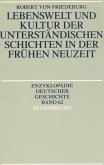The practice of feuding amongst noblemen and princes represented a substantial threat to law and order, yet it was widely accepted and deeply embedded in late medieval and early modern German society. Hillay Zmora offers a new interpretation of this violent social practice, which has long confounded historians and social scientists. His groundbreaking study explains feud violence in its social context, demonstrating that, paradoxically, nobles feuded mostly not against strangers but with neighbours, relatives and their feudal lords. Focusing on the ambivalent relationships and symbolic communication between nobles, this study explores how values, norms and moral sentiments linked to reciprocity provided the most powerful incentives to engage in violent conflict. It will be essential reading for historians, anthropologists, psychologists and anyone who seeks to understand the link between culture, moral systems and endemic violence.
Hinweis: Dieser Artikel kann nur an eine deutsche Lieferadresse ausgeliefert werden.
Hinweis: Dieser Artikel kann nur an eine deutsche Lieferadresse ausgeliefert werden.
'Ever since Otto Brunner, the phenomenon of the feud in the late Middle Ages and the early modern period has been a constant (and contested) subject-matter in the historiography. But despite all the debates and controversies that have surrounded this theme, the time seems ripe for a new synthesis which, building on recent research, offers overarching interpretations. Such a synthesis is presented by Hillay Zmora ... an important interpretation that will stimulate further research of the noble feud in the late Middle Ages and the beginning of the modern era.' Sven Rabeler, translated from Historische Zeitschrift








